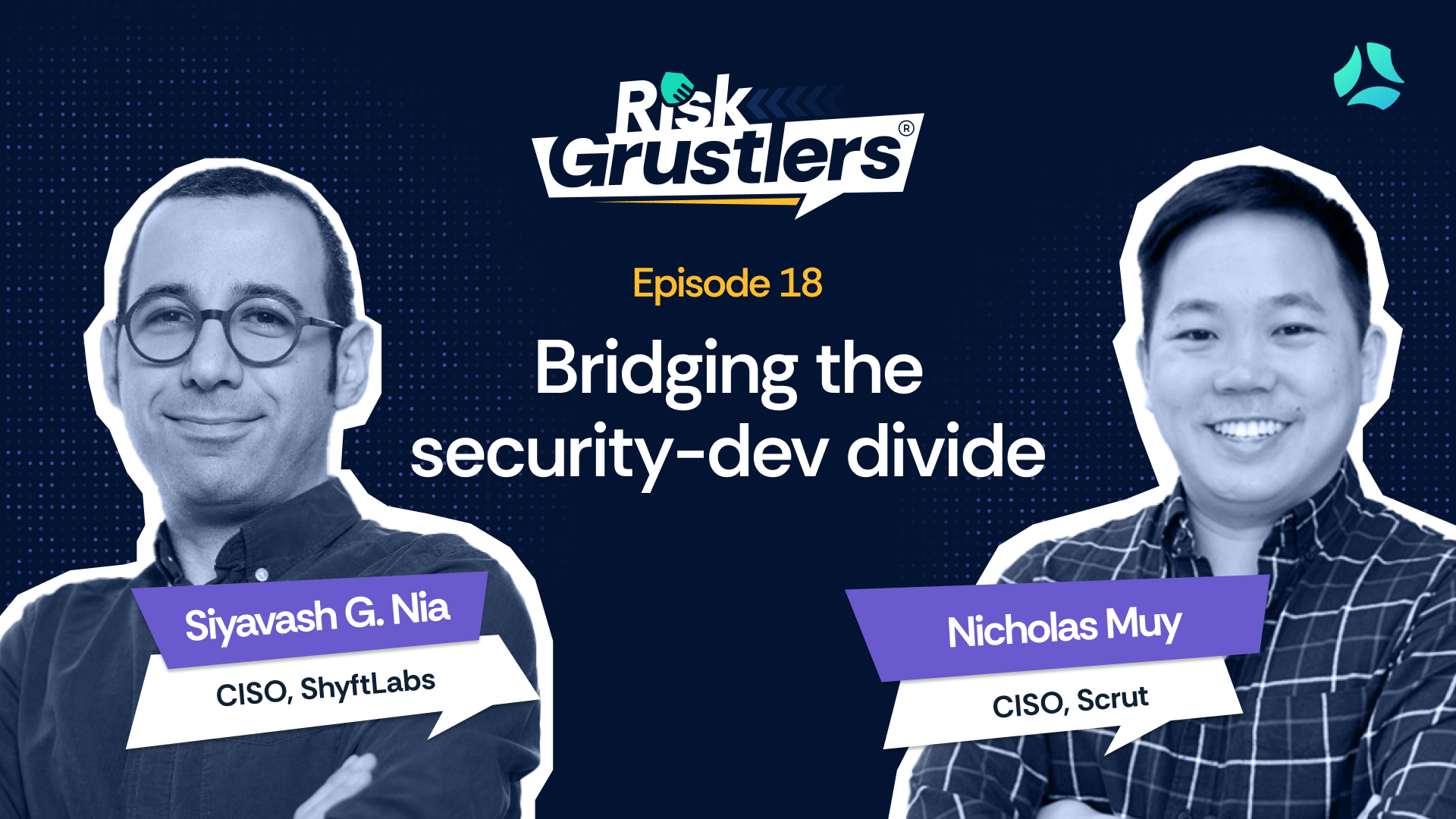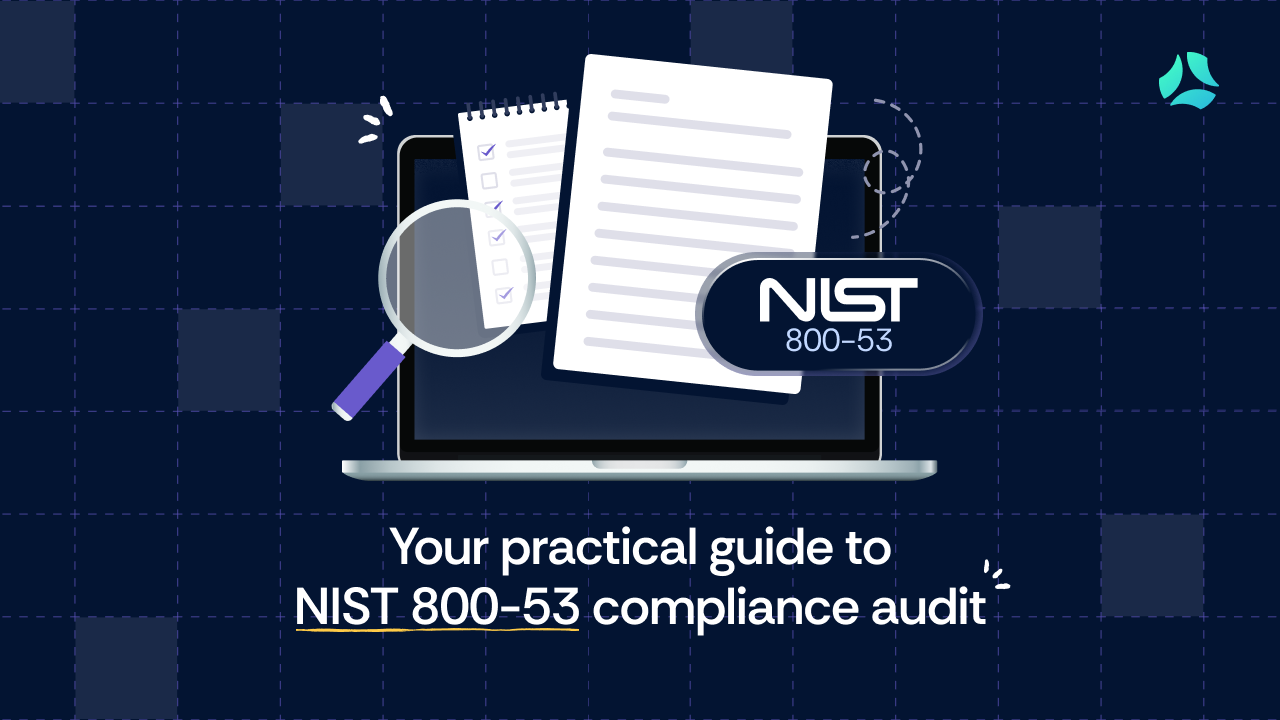Streamlining compliance risk management: Best practices to follow

Compliance risk management addresses the problem of ensuring that organizations adhere to relevant laws, regulations, and standards, thereby mitigating the risks associated with non-compliance. It is a critical component of enterprise risk management, focusing specifically on the regulatory aspect to create a compliant and resilient operational environment.
In this article, we will learn all about compliance risk management and the best practices a business can follow for its effective implementation.
What is compliance risk management?
Compliance risk management is the process of identifying, assessing, and mitigating risks associated with an organization’s failure to adhere to applicable laws, regulations, standards, and internal policies.
This process involves continuous monitoring and reviewing of compliance policies, procedures, and training materials to ensure that the organization remains compliant and avoids legal penalties, financial losses, and reputational damage.
Effective compliance risk management helps organizations navigate complex regulatory environments, ensuring that they operate within legal and ethical boundaries while safeguarding their business interests.
Importance of risk assessment in compliance management
Risk assessment is a critical component of compliance management as it helps organizations identify, evaluate, and mitigate potential risks associated with regulatory laws, standards, and policies. By conducting regular compliance risk assessments, organizations can prioritize their resources and efforts toward addressing the most significant risks.
Risk assessments provide a structured process that enables organizations to systematically identify and analyze compliance risks, offering insights into the strengths and weaknesses of their compliance programs. This process allows organizations to proactively address vulnerabilities and ensure that their operations remain compliant with relevant regulations.
Furthermore, risk assessments help organizations to continuously improve their compliance strategies by highlighting areas for improvement and enabling them to adapt to changing regulatory environments. This ongoing evaluation and adjustment are essential for maintaining robust compliance management and fostering a culture of accountability and transparency within the organization
Why compliance risk management matters
Compliance risk management is crucial for organizations to avoid the significant costs and operational disruptions associated with non-compliance. Recent statistics highlight the importance of effective compliance risk management. For example, over 100 compliance statistics compiled for 2024 reveal that non-compliance can result in severe financial penalties, reputational damage, and operational inefficiencies.
A key statistic shows that 58% of compliance teams report challenges in gauging vendor compliance, underscoring the need for robust third-party risk management. Additionally, compliance concerns are a major issue, with 68% of risk management employers feeling that their compliance departments are insufficiently resourced to handle the growing demands.
How to implement compliance risk management?
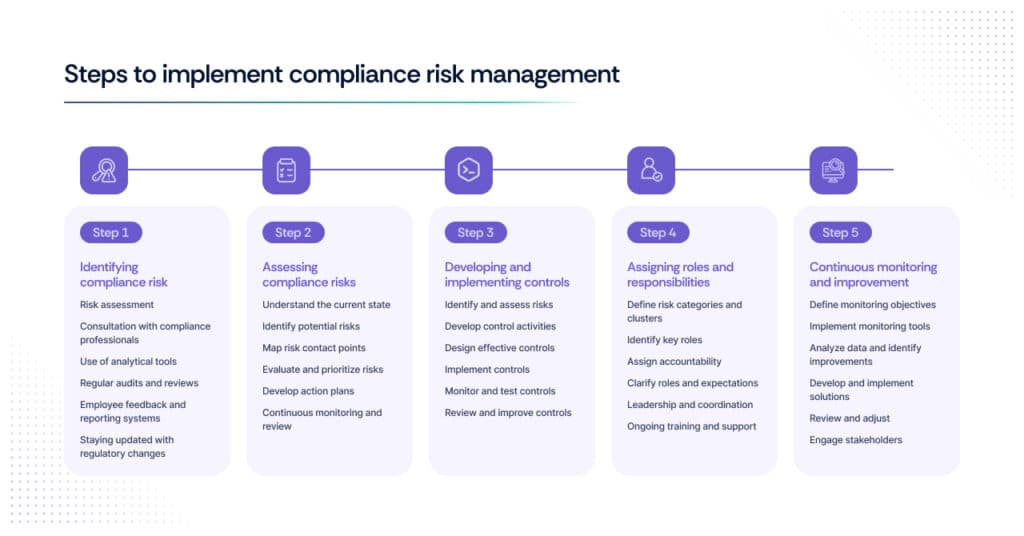
Step1: Identifying compliance risk
Identifying compliance risks is a crucial step in managing and mitigating potential non-compliance issues within an organization. Here are some best practices for identifying these risks:
1. Risk assessment
Conduct thorough risk assessments to identify areas where the organization may face compliance challenges. This includes evaluating current compliance status and identifying potential gaps.
2. Consultation with compliance professionals
Engage compliance professionals to help identify and evaluate potential risks. Their expertise can provide valuable insights into areas that might be overlooked internally.
3. Use of analytical tools
Utilize various analytical tools such as risk maps, process flows, and key risk indicators to systematically identify and visualize compliance risks.
4. Regular audits and reviews
Perform regular audits and reviews of compliance processes and controls. This helps in uncovering hidden risks and ensures that existing controls are effective.
5. Employee feedback and reporting systems
Establish channels for employees to report potential compliance issues anonymously. Employee feedback can be a vital source of information for identifying risks that might not be visible to management.
6. Staying updated with regulatory changes
Keep abreast of changes in relevant laws and regulations. Regularly updating the compliance framework to reflect new requirements helps in proactively identifying new risks.
Step 2: Assessing compliance risks
Assessing compliance risks involves systematically identifying, evaluating, and prioritizing risks associated with non-compliance to ensure effective risk management. Here are the key steps to conducting a compliance risk assessment:
1. Understand the current state
Begin by evaluating the organization’s current compliance status. Understand existing policies, procedures, and controls to identify any gaps or areas needing improvement.
2. Identify potential risks
Identify potential compliance risks by analyzing regulatory requirements, industry standards, and internal policies. Consider risks associated with financial, operational, and reputational impacts.
3. Map risk contact points
Map out all potential risk contact points within the organization. This involves identifying all areas and processes that could be affected by compliance risks.
4. Evaluate and prioritize risks
Assess the likelihood and impact of identified risks. Use a risk matrix to prioritize risks based on their potential impact and the likelihood of occurrence. This helps in focusing resources on high-priority risks.
5. Develop action plans
Develop action plans to mitigate prioritized risks. This includes designing and implementing controls, policies, and procedures to address identified risks effectively.
6. Continuous monitoring and review
Continuously monitor and review the effectiveness of risk management measures. Regularly update the risk assessment to reflect changes in regulations, business operations, and identified risks.
Step 3: Developing and implementing controls
Developing and implementing controls is a crucial part of managing compliance risks. Effective controls help mitigate identified risks, ensuring the organization adheres to laws, regulations, and internal policies. Here are the steps to develop and implement effective controls:
1. Identify and assess risks
Start by conducting a comprehensive risk assessment to identify potential compliance risks. This involves understanding the current state of affairs, mapping potential risk contact points, and evaluating the likelihood and impact of each risk.
2. Develop control activities
Based on the identified risks, develop control activities that address these risks. Controls should be clearly documented and communicated to all stakeholders and staff to ensure proper implementation.
3. Design effective controls
Ensure that the controls are well-designed to mitigate the specific risks identified. This includes creating policies, procedures, and standards that are practical and enforceable.
4. Implement controls
Implement the designed controls within the organization’s processes. This involves training employees on new procedures, integrating controls into daily operations, and ensuring that everyone understands their role in maintaining compliance.
5. Monitor and test controls
Continuously monitor the effectiveness of the controls. Regular testing and audits can help ensure that controls are working as intended and identify areas for improvement.
6. Review and improve controls
Periodically review and update the controls to reflect any changes in regulations, business processes, or identified risks. Continuous improvement ensures that the controls remain effective and relevant.
Step 4: Assigning roles and responsibilities
Assigning roles and responsibilities is a critical aspect of effective compliance risk management. Clear delineation of duties ensures accountability and helps in managing risks efficiently. Here are the key steps:
1. Define risk categories and clusters
Functional and strategic managers should define the risk categories relevant to their areas and ensure that responsibilities are appropriately clustered].
2. Identify key roles
Common roles in Governance Risk management and Compliance (GRC) include the Chief Risk Officer (CRO), risk compliance managers, and other relevant personnel who handle specific tasks such as remediation, risk response, and advanced risk assessment.
3. Assign accountability
Clearly assign accountability for managing identified risks to specific individuals or teams. This includes designating risk owners who are responsible for monitoring and mitigating particular risks.
4. Clarify roles and expectations
Ensure that everyone involved understands their roles and expectations. This helps in clarifying responsibilities and prevents overlaps or gaps in risk management activities.
5. Leadership and coordination
The Chief Risk Officer (CRO) typically leads the enterprise risk management (ERM) team and coordinates with organizational leaders on risk response strategies and continuous improvement initiatives.
6. Ongoing training and support
Provide ongoing training and support to all individuals involved in risk management. This ensures they have the necessary skills and knowledge to perform their duties effectively.
Step 5: Continuous monitoring and improvement
Continuous monitoring and improvement are crucial for maintaining compliance and enhancing organizational processes. Here are the key steps involved:
1. Define monitoring objectives
Clearly define what needs to be monitored and why. This includes setting objectives related to compliance, security, and process efficiency.
2. Implement monitoring tools
Utilize appropriate tools and technologies to continuously observe and collect data on key performance indicators (KPIs). These tools help identify deviations and potential issues in real time.
3. Analyze data and identify improvements
Regularly analyze the collected data to identify trends, patterns, and areas for improvement. This analysis helps in understanding the root causes of issues and potential risks.
4. Develop and implement solutions
Based on the analysis, develop solutions to address identified issues and improve processes. Implement these solutions and monitor their effectiveness.
5. Review and adjust
Continuously review the implemented changes to ensure they are effective. Make necessary adjustments and improvements to enhance overall compliance and process efficiency.
6. Engage stakeholders
Involve stakeholders in the monitoring and improvement process. Regularly communicate findings and improvements to ensure everyone is aligned and committed to maintaining high standards.
Best practices for compliance risk management
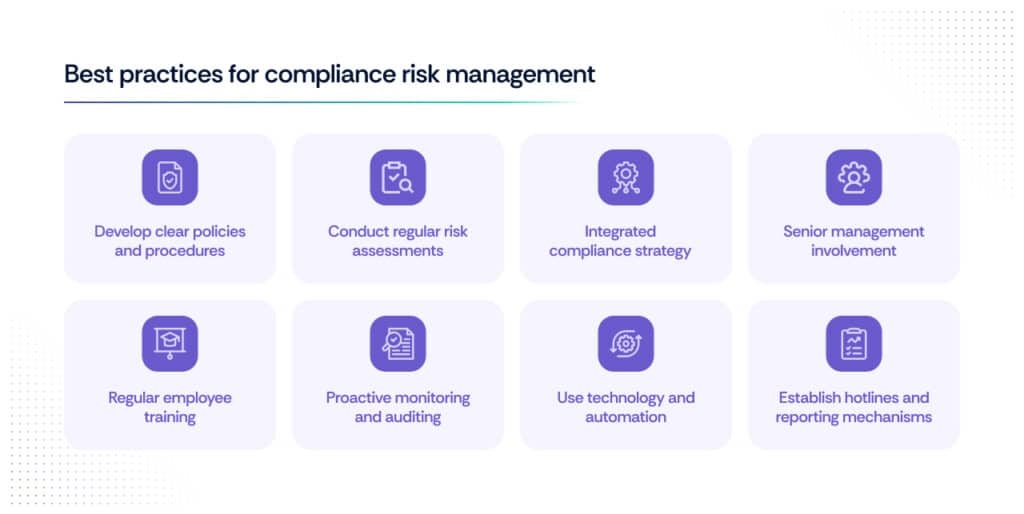
Effective compliance risk management involves deploying strategic measures to identify, evaluate, monitor, and mitigate potential threats. Here are some best practices to follow:
1. Develop clear policies and procedures
Establish clear, comprehensive policies and procedures that define compliance requirements and expectations. Ensure these documents are accessible to all employees.
2. Conduct regular risk assessments
Regularly assess and analyze risks to identify potential compliance issues. This helps prioritize risks based on their likelihood and impact.
3. Integrated compliance strategy
Implement an integrated compliance strategy that aligns with the organization’s overall risk management framework. This ensures a cohesive approach to managing compliance risks.
4. Senior management involvement
Ensure that senior management is actively involved in the compliance risk management process. Their support and commitment are crucial for the successful implementation of compliance measures.
5. Regular employee training
Conduct regular training sessions to educate employees about compliance policies and procedures. This fosters a culture of compliance and ensures everyone is aware of their responsibilities.
6. Proactive monitoring and auditing
Implement continuous monitoring and regular audits to detect and address compliance issues promptly. This helps maintain compliance and identify areas for improvement.
7. Use technology and automation
Leverage technology and automation tools to streamline compliance processes, enhance efficiency, and ensure timely adherence to regulatory changes.
8. Establish hotlines and reporting mechanisms
Provide employees with anonymous reporting mechanisms, such as hotlines, to report compliance concerns without fear of retaliation. This encourages a proactive approach to identifying and addressing potential issues.
How does Scrut leverage technology for compliance risk management?
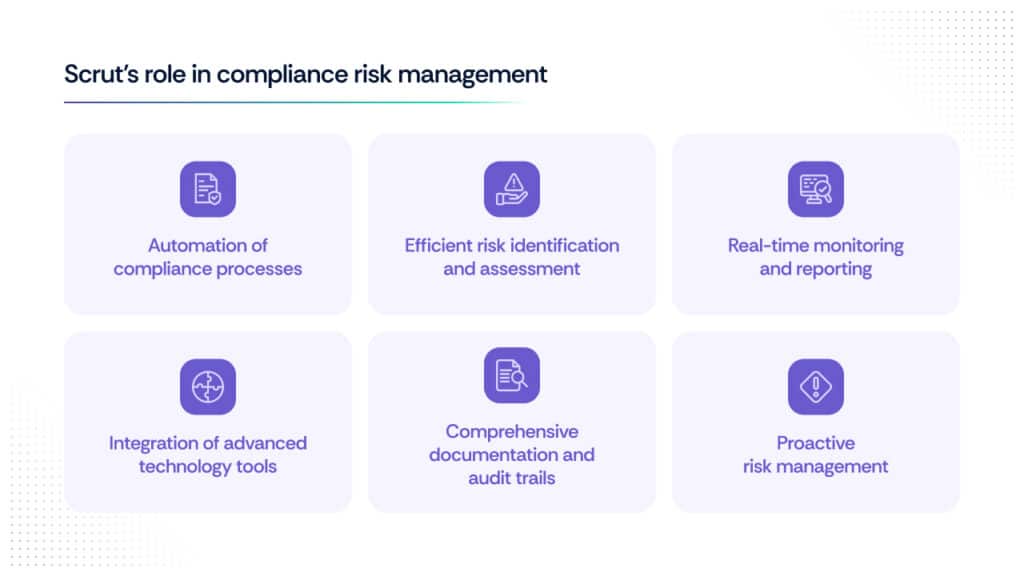
There are many compliance management software in the market today. Scrut leverages advanced technologies to enhance governance, risk management and compliance in several key ways:
1. Automation of compliance processes
Scrut automates compliance processes, which helps organizations streamline their operations and reduce manual efforts. This includes automating routine compliance checks and monitoring tasks, ensuring timely adherence to regulatory changes.
2. Efficient risk identification and assessment
By leveraging automation, Scrut enhances the efficiency, accuracy, and scalability of identifying, assessing, and mitigating potential risks. This allows businesses for proactive risk and compliance management.
3. Real-time monitoring and reporting
Scrut provides real-time monitoring and reporting capabilities, enabling organizations to keep track of compliance status continuously. This ensures that any deviations or issues are promptly detected and addressed.
4. Integration of advanced technology tools
Scrut integrates various advanced technology tools such as data analytics and machine learning to analyze compliance-related data. These tools help in identifying patterns, trends, and potential risks, providing valuable insights for better decision-making.
5. Comprehensive documentation and audit trails
Scrut’s platform ensures comprehensive documentation and audit trails, which are crucial for regulatory audits and internal reviews. This capability helps organizations demonstrate compliance and maintain transparency in their operations.
6. Proactive risk management
Scrut empowers organizations to take a proactive approach to risk management by providing tools that help in the early detection and mitigation of compliance risks. This proactive stance helps in preventing potential issues before they escalate.
Winding up
In conclusion, effective compliance risk management is vital for organizations to avoid legal penalties, financial losses, and reputational damage. By systematically identifying, assessing, and mitigating risks, businesses can ensure adherence to regulations and standards.
Regular risk assessments, robust controls, clear roles, and continuous monitoring are key components. Leveraging technology, as shown by platforms like Scrut, enhances efficiency and effectiveness. Prioritizing compliance risk management fosters a culture of accountability and supports long-term business success.
Ready to enhance your compliance risk management? Discover how Scrut can streamline your processes, ensure regulatory adherence, and protect your organization from potential risks. Take the first step towards a compliant and resilient business environment. Request a demo today!
FAQs
1. What is compliance risk management?
Compliance risk management is the process of identifying, assessing, and mitigating risks associated with an organization’s failure to adhere to applicable laws, regulations, standards, and internal policies. It involves continuous monitoring and reviewing to ensure the organization remains compliant and avoids legal penalties, financial losses, and reputational damage.
2. Why is compliance risk management important?
Compliance risk management is crucial to prevent legal penalties, financial losses, and damage to an organization’s reputation. It ensures that businesses operate within legal and ethical boundaries, safeguarding their interests and enhancing overall business performance.
3. How can organizations identify compliance risks?
Organizations can identify compliance risks through risk assessments, consultations with compliance professionals, using analytical tools, conducting regular audits, gathering employee feedback, and staying updated with regulatory changes.



